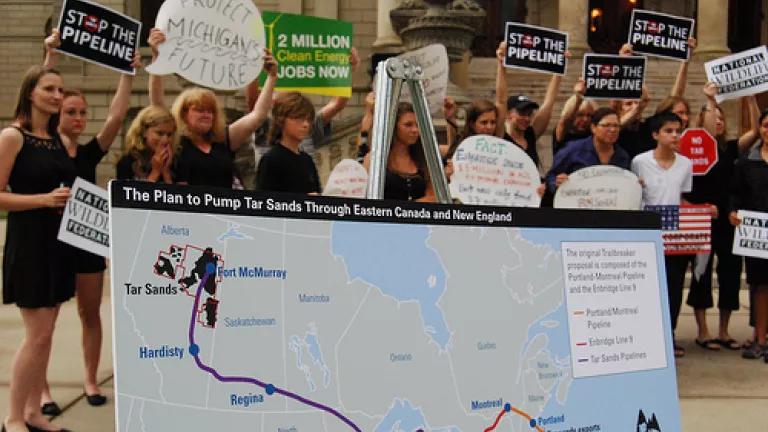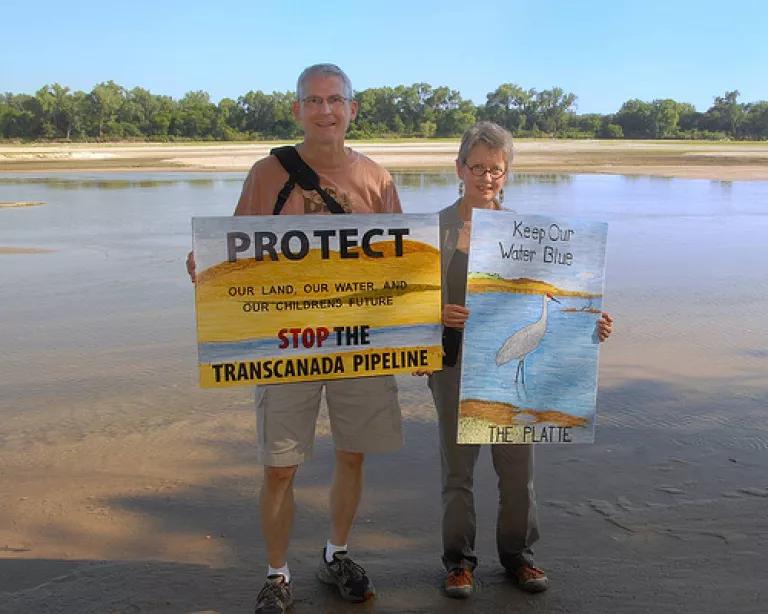
On the two-year anniversary of the largest tar sands spill in U.S. history into Michigan’s Kalamazoo River, citizens in dozens of communities across North America facing existing or proposed tar sands pipelines are banding together with a simple message: It could happen here. More than twenty-four We Are the Kalamazoo citizen events are being held in the U.S. and Canada throughout the week signaling a tar sands spill like the one in Michigan could happen to anyone. There have already been events including a “human oil spill” at the state capitol in Lansing, Michigan (picture below). Other human oil spills, actions and demonstrations will be held in Vermont, Maine, Delaware, Montana, Nebraska, Oklahoma, and Washington state in the U.S. and Quebec, British Columbia, and Ontario in Canada. Most of the citizen actions will occur today exactly two years after tar sands pipeline operator Enbridge Inc. spilled 1.2 million gallons of raw tar sands, or diluted bitumen, into the Kalamazoo River contaminating nearly 40 miles of the watershed. Today, after a federal cleanup effort led by the EPA, there are still nearly 400 acres of the watershed still contaminated with tar sands oil.
One of the key learnings from the Kalamazoo spill is that tar sands oil is much more devastating to the environment than conventional oil. When it spills from a pipeline, it separates from the chemicals it is mixed with and then sinks in waterbodies (unlike conventional oil which floats on the water’s surface). Tar sands diluted bitumen also has the potential to cause more frequent and serious spills than the industry has previously experienced with conventional crude oil. Indeed, Between 2007 and 2010, pipelines in the Northern Midwest which transport more tar sands crude than any other region of the U.S. have spilled three times more oil per mile than the national average. Here is why:
It is acidic. Tar sands diluted bitumen normally has organic acid concentrations up to 20 times higher than conventional crude oil, and contains up to 10 times more sulfur.
It is hot. Tar sands diluted bitumen flowing through pipelines creates friction, which raises the material’s temperature and amplifies its corrosive qualities.
It is abrasive. Tar sands diluted bitumen has suspended in its mixture abrasive materials like quartz and pyrite and particles.
It is viscous. Tar sands diluted bitumen is 40 to 70 times more viscous than North American conventional crude oil. This high viscosity requires tar sands pipelines to operate at higher pressures than conventional pipelines.

The two year anniversary of the Kalamazoo tar sands spill follows a National Transportation Safety Board (NTSB) report issued last week raising serious questions about whether corrosive tar sands can be safety moved on the U.S. pipeline system. The NTSB report was also a searing indictment of pipeline company Enbridge who is planning major tar sands expansions throughout the Midwest and possibly into New England. U.S. pipeline regulators recently announced the largest fine ever proposed saying Enbridge likely violated two dozen regulations.
While we grapple with whether tar sands can be safely piped through the U.S. pipeline system, there are many proposals for new or expanded tar sands pipelines. There are many existing tar sands pipelines and many more proposed routes all over North America. There are also new tar sands pipelines that are being proposed such as Keystone XL would carry the same raw tar sands oil from Canada over America’s heartland to the Gulf Coast for export. The proposed Enbridge Midwest expansion and Trailbreaker pipeline project – would bring tar sands oil through the Great Lakes and across fragile New England rivers and lakes to Portland, Maine for export.
The voices of these citizens drawing attention to the risks of tar sands pipelines should be heeded. One thing is clear: We are not talking about conventional oil. We are dealing with a corrosive substance that is difficult and sometimes impossible to clean up. As the U.S. decides whether to build new tar sands pipelines like Keystone XL, these issues must be addressed. In the end, the cost of a tar sands spill to the environment and the local economy will almost always outweigh the need for the U.S. to ship Canadian tar sands through its landscape.
